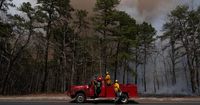A massive wildfire has been raging in New Jersey's Pine Barrens since Tuesday, April 22, 2025, consuming over 5,300 hectares (approximately 13,250 acres) of land and prompting the evacuation of thousands of residents. Known as the "Jones Road" fire, it has been described by officials as one of the most severe wildfires in the state's recent history, with containment efforts currently at 50% as of Thursday, April 24, 2025.
The fire broke out around 10 a.m. in the Greenwood forest area, quickly spreading due to dry conditions and strong winds. Local authorities reported that approximately 5,000 residents from the municipalities of Lacey and Ocean were forced to evacuate their homes as a precautionary measure. Interim Governor of New Jersey, Tahesha Way, declared a state of emergency for Ocean County, effective from 7 a.m. on Wednesday, April 23, 2025, to facilitate the deployment of resources needed to combat the blaze.
According to CBS Philadelphia, the fire has destroyed a commercial building and numerous vehicles, leaving nearly 25,000 residents without power temporarily. However, no injuries or fatalities have been reported, with Lacey's Mayor, Peter Curatolo, confirming that no homes have been damaged. "Aucune habitation n’a été endommagée et personne n’a été ni blessé ni tué," he stated, emphasizing the effectiveness of the evacuation efforts.
As of Thursday, the New Jersey Forest Fire Service reported that the fire remains active, with 20 buildings still threatened and several roads blocked due to the ongoing emergency. The smoke from the fire is spreading inland, prompting health alerts in New York City regarding air quality, as officials warn that the smoke could reach the city in the coming days.
This wildfire is particularly alarming, as it comes amid a drought alert that has been in place since March 2025. The dry conditions, coupled with low humidity and strong winds, have created an ideal environment for wildfires, making containment efforts challenging. Shawn LaTourette, Commissioner of the New Jersey Department of Environmental Protection, noted, "L'incendie est toujours très actif. La superficie des terres va augmenter, et ce, dans une zone encore inhabitée." He highlighted the difficulties faced by firefighters battling the flames in such adverse conditions.
Local residents have described the atmosphere near the fire as chaotic, with thick smoke filling the air and emergency sirens blaring. One resident, Debi Schaffer, recounted her evacuation experience, humorously recalling her struggle to transport her chickens: "Je voulais emmener [nos poules] dans la voiture avec moi; pouvez-vous imaginer 22 poules dans une voiture?" Fortunately, her home remained safe, as did the nearby alpaca farm, where all animals were reported unharmed.
Firefighting efforts are ongoing, with crews working around the clock to contain the blaze. Firefighters have implemented various strategies, including controlled burns to prevent the fire from spreading further. The Pine Barrens, a protected area known for its unique ecosystems and wildlife, is particularly vulnerable to such fires, especially during the spring fire season.
Historically, New Jersey has faced several significant wildfires, with this incident being compared to the devastating fire of 2007 that burned 26 square miles. The current blaze is now being referred to as the second most serious fire in the last two decades, raising concerns about the increasing frequency and severity of wildfires in the region.
As firefighters continue their efforts, officials are hopeful that predicted rain later this week may assist in controlling the fire. Until then, residents are advised to stay alert, avoid wooded areas, and heed emergency alerts. The situation remains fluid, and authorities are working diligently to ensure the safety of the affected communities.
In summary, the Jones Road wildfire represents a significant challenge for New Jersey, highlighting the urgent need for effective fire management strategies in the face of changing climate conditions. With the fire still active and containment efforts ongoing, the community remains on high alert as they navigate the aftermath of this environmental disaster.




